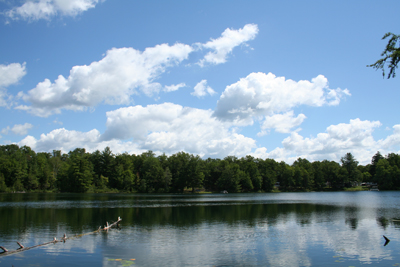Pottawatomie, Ottawa and Chippewa Indians were first inhabitants of Webber Township. First white came near the end of the Civil War. At first they hunted, fished and cleared small tracts for farming. Starting in the 1870’s a booming demand for timber brought up an influx of people engaged in timber cutting. Several settlements and villages sprang up around the county to serve the needs of this growing timber industry. However, there were none in Webber Township, probably because the Village of Baldwin, just south of the Township, met the needs of the loggers and settlers.
By the early 1900’s most of the prime timber in Webber Township and vicinity had been cut. Some of the cutover land was sold to city dwellers looking for a better life. Some was sold to individuals or groups for recreational purposes. Many of the people who tried to farm the land found that the soil and climate made it very hard to make a living. During the depression of the 1930’s, much of this farm land reverted to the State because owners could not pay their taxes. Tax delinquency, then, is one of the reasons why 45 percent of the land in Webber Township is owned by either the State or Federal Government.
In the 1930’s land owned by the State was organized into State Forests. The State Forest land east of M37 in Webber Township became part of the Pere Marquette State Forest. The federal government also purchased cut-over and tax delinquent land in Michigan during the Great Depression. The land they purchased west of M37 in Webber Township became part of the Huron-Manistee National Forest. The men of the Civilian Conservation Corps planted trees on much of this State and Federal land. By the end of World War II, plantations and natural regrowth of trees along with cheap land made the area attractive for retirement and second homes. Many were attracted by the possibility of owning their own little “cabin in the woods” on their own land where they thought that the cost of living would not be as high as it was in cities.
By the early 1900’s people from cities to the south started coming to Webber Township and the surrounding area simply to get away form the city and enjoy hunting, fishing and a generally more relaxed life style. This activity was centered around water and usually involved a family or other group with a common background. One such group, which called itself the “Mahoning Camping Club”, had their camp on Whalen Lake. The Bradfords were another family group that camped on Little Star Lake.
In the 1920’s speculators started subdividing land into small parcels that could be sold cheaply. One of the first subdivisions in Webber Township was Whalen Lakes Resort which was platted in 1921. Whalen Lakes Resort No.1 was platted in 1924, and the year after, two subdivisions were platted on Bush Lake. This process continued until by 1930 most of the larger parcels along M37 had been platted. Many of these subdivisions were made up of lots only 30 feet wide. That is the origin of the crowded conditions around some lakes and in some residential districts.
